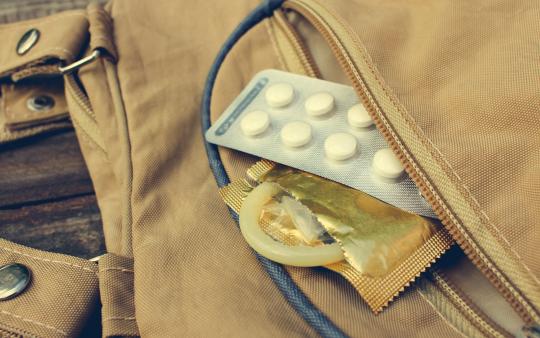Many women are looking for birth control options without hormones that are comparable to oral contraceptive pills for effectiveness. While the pill is an overwhelmingly popular, valid, and convenient choice, hormonal contraceptives have a range of minor to serious side-effects that need extra health support to manage. Fortunately, many non-hormonal birth control methods are highly successful and don’t come with the added burdens that chemical contraceptives place on your body.
Paragard Intrauterine Device (IUD)
Effectiveness rate: >99%
This is a T-shaped copper device that sits at the top of your uterus (fundus) and works by preventing fertilization. The copper creates an inhospitable environment for sperm and eggs that renders them inactive before they even have a chance to hook up. Though it’s been around since the 1960’s, recent attention to IUDs in general and interest in non-hormonal contraception in particular have seen a rise in popularity.
Pros:
- One of the most reliable methods of birth control available, touting a less than 1% failure rate, it is immediately effective after insertion.
- A great option for those tracking their cycles but want the convenience of a method they don’t have to think about. You get to know your body and are still able to pick up on fertile signs because it allows your hormones to function normally.
- Good alternative for anyone who may be affected by depression or anxiety from other hormonal contraceptives.
- “Set it and forget it”: It lasts up to 10 years, no fertility tracking necessary, and no seeking out or unwrapping protection at a moment’s notice.
Cons:
- Ouch! The insertion process is quick but does tend to pinch a little, and many gynecologists will recommend taking ibuprofen an hour before the procedure to relieve pain. Occasionally Cytotec (misoprostol) will be prescribed to help open the cervix slightly, allowing for a more comfortable insertion.
- Many users report increased levels of cramping and bleeding so if you have a history of heavy periods and cramping, this one may not be your best option.
CONDOMS
Effectiveness rate: 98%
Condoms provide a physical barrier method by covering the penis with a balloon-like sheath with a reservoir at the tip for ejaculate. When used correctly, they are a very effective and convenient non-hormonal option for contraception.
Pros:
- Widely available, accessible to anyone, and effective immediately.
- A variety of materials, including polyurethane, lamb intestine, and vegan options, can be used by those with a latex allergy.
- Often made with pleasure-enhancing features such as lubricant and ribbing.
- Offers protection against some sexually transmitted infections.
Cons:
- Easily forgotten and should always be kept on hand.
- Must fit and be used correctly.
- Creates waste.
- They do expire.
DIAPHRAGM
Effectiveness rate: 92–96%
Diaphragms are, in a sense, the female version of a condom. These are dome-shaped and inserted vaginally to create a “cap” around the cervix, preventing semen from entering the uterus. Oftentimes a spermicidal jelly is applied for an added layer of protection. You can get a prescription for a diaphragm from your health care provider.
Pros:
- Wash and re-use!
- Portable and effective immediately.
- Can be inserted several hours before sex.
- Can last up to two years with proper care.
Cons:
- Can get a bit messy.
- Must fit correctly.
FERTILITY AWARENESS METHOD
Effectiveness rate: 99.4% (when carefully observed)
Women are actually only fertile for a few days a month. Our bodies give us lots of signs, and when you are aware of these signals, you can know when ovulation is occurring and practice abstinence or diligently use other contraception during that small fertile window (just as you can utilize the signals for easier conception!). The fertility awareness method, also called natural family planning, is a great choice for couples who have regular cycles, discipline, and are somewhat open to a pregnancy.
Pros:
- No prescriptions, no procedures, and it’s completely free!
- Nothing to remember to bring along, nothing to interrupt the moment, nothing to dispose of.
- Because it doesn’t rely on hormones to artificially stifle ovulation, it also allows you to get pregnant more easily when you do want to.
Cons:
- Requires abstinence on those fertile days, so either self-control or keeping physical barriers at the ready is paramount for those “heat of the moment” occasions.
- Challenging to learn. You must stay assiduously on top of symptom tracking as one missed day could mean an unplanned pregnancy.
Signs you are fertile
By paying attention to your menstrual cycle and these fertility signals, you can know when you should abstain from unprotected intercourse in order to prevent pregnancy.
Cervical mucus consistency changes
Estrogen, dominant in the follicular phase (day 1–14), is responsible for creating slippery cervical mucus. Your cervical mucus becomes slick and stretchy like egg whites to create a physiological “ladder” for sperm to climb up easily into the uterus and fallopian tubes!
Cervical height increases
Your cervix moves into a “high” position so sperm can more easily enter the uterus—it may even raise up higher than you can easily reach.
Cervix opens
The cervix (the doughnut shaped ring at the top of your vaginal canal, the same spot you get swiped during a pap smear) has an opening called the “Os” which actually opens up a bit during ovulation in order for the sperm to gain easy passage. It should feel more open compared to the days before or after.
Cervix softens
The cervix also becomes soft like the apple of your cheek. When it is hard—like the tip of your nose—you are not likely fertile.
Basal body temperature increases
Progesterone, dominant in the luteal phase (day 15–28), is produced after ovulation and increases the internal body temperature of a woman so your basal body temperature will raise about 0.2 degrees Fahrenheit above your normal. If you see this temperature spike (using a special thermometer for this purpose), you can be confident you’ve ovulated, and there is a high chance of getting pregnant in this window.
After ovulation, an egg only survives for 24–48 hours so if it isn’t fertilized in that time, conception likely won’t happen. However, sperm can stick around for about 4–7 days, so to be on the safe side, consider yourself fertile for 4–7 days a month. Consider taking a course with a Fertility Awareness Method/Natural Family Planning instructor or read a book like Taking Charge of Your Fertility by Toni Weschler.
It’s great news that there are many types of non-hormonal birth control. All methods have strengths and weaknesses, including the pill, so consider these very effective options in your plan to prevent or delay pregnancy. In any case, the best contraception is the contraception that is right for you!






